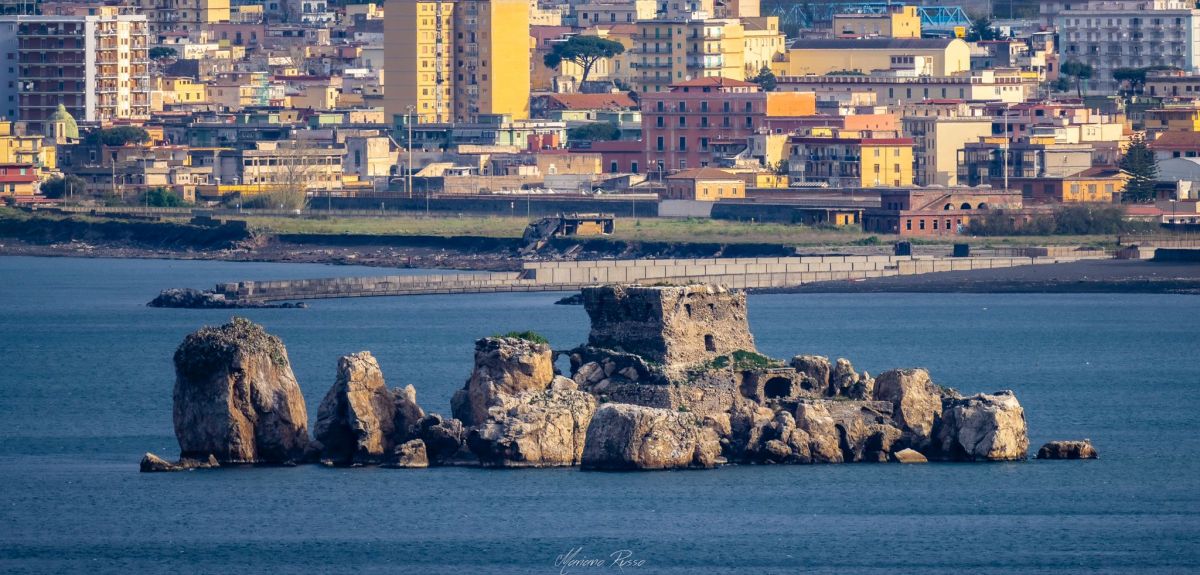Scoglio they call it in Castellammare di Stabia and in Torre Annunziata, from where it can be clearly observed in the middle of the sea, a short distance from the coast.
A familiar definition for the small island of Rovigliano, just six thousand square meters of surface for a group of rocks, joined together by man even before the Romans discovered and appreciated its favorable position in the Gulf of Naples, in front of the mouth of the Sarno. What remains visible, perhaps, of a large mountain sunk into the sea due to a geological event that is lost in the mists of time. Limestone rocks of the same nature as the Lattari Mountains, which dominate that stretch of coast.
Elements that the myth has reworked and embellished, assigning the origin of the islet to Hercules who, passing through those shores returning from his tenth effort, would have thrown the top of Mount Faito into the sea, to be able to rest more comfortably. And, in fact, for the ancients the islet was the "Petra Herculis". There where, according to Pliny the Elder, a temple dedicated to the god once stood. Pliny himself, who had chosen that strip of land in the sea to observe the eruption of Vesuvius more closely, was seized by the fumes that gave him death. And since then the "Hercules Stone" became the "Pliny Stone".
The Vesuvius tragedy marked a drastic change from the previous life of the small island. Where the remains of structures in opus reticulatum could go back either to the temple or to a villa of the gens Rubellia, who produced wine in nearby Pompeii. The name "Rubellianum" derives from their name or that of Count Rubelio, who became its owner in the Middle Ages. It was Pope Innocent III who mentioned it, for the first time, in a written document, to indicate the border between the dioceses of Naples and Nola.
In the 5th century AD. the Benedictines arrived on the island of Rovigliano, who built a monastery dedicated to the Archangel Michael, authorized in 1220 by Pope Honorius II to adopt the Forensic Rule.
When the Lombards occupied Castellammare in the 9th century, Count Orso settled on the islet with his wife Fulgida, a woman who was soon admired for her great beauty and charitable spirit, and their little son Miroaldo. In Castellammare, on the other hand, the garrison was staying. That tranquility was interrupted by a Saracen attack launched from the sea. It didn't take long for the assailants to get the better of the soldiers on the mainland. Nor to overcome the strenuous resistance opposed on the island. Fulgida, in an attempt to save her husband's life, was struck by a spear and lost consciousness. Waking up, she found carnage and her husband hanged, no trace of her son, who had been kidnapped by the invaders to enslave him. Soon after, she too died. From that moment, according to legend, in the evening her ghost roams restlessly around the islet, in search of her loved ones, always accompanied by the flight of seagulls.
The decline of the oldest structures began in the fourteenth century, in the sixteenth century the islet returned to assume a precious role in defending the coast and the port of Castellammare against Turkish raids. On the ruins of the monastery a twenty-metre high tower was built, one of the most important in the Gulf of Naples. A couple of centuries later the fortress was restructured by order of Charles of Bourbon. Then it became barracks and prison. With the unification of Italy, the original defensive purpose no longer existed, the tower was first sold to private individuals, then in 1925 it was declared a national monument. Soon abandoned, the Scoglio di Rovigliano has remained uninhabited ever since.





Comments powered by CComment